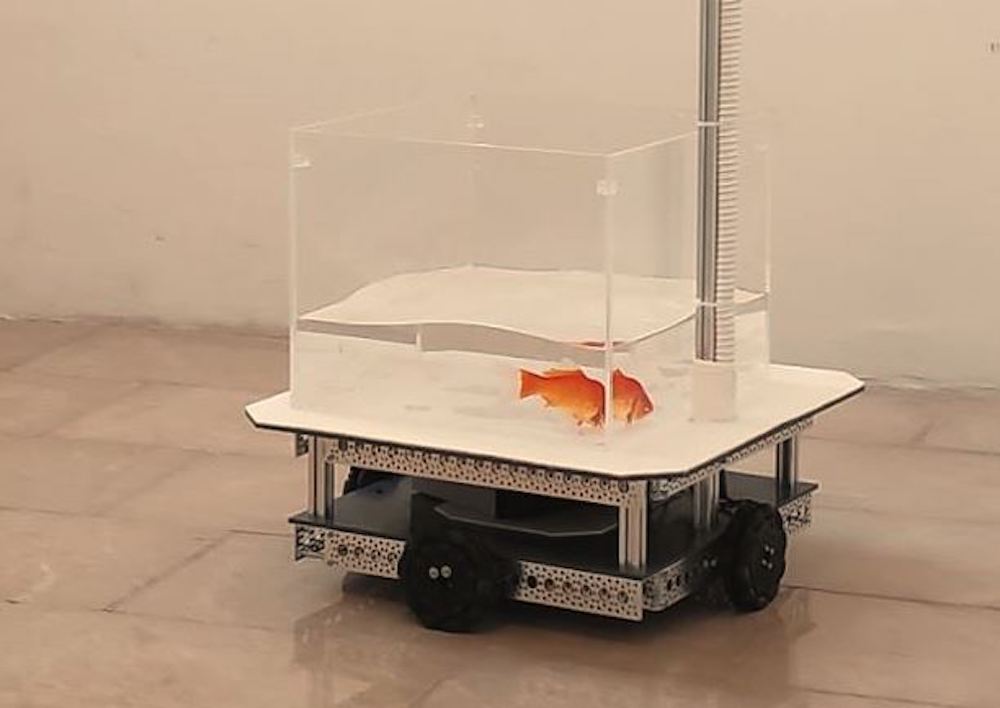Create a free profile to get unlimited access to exclusive videos, sweepstakes, and more!
Ancient fish learned to walk on land, now modern fish have learned to drive
If fish ever get a hold of those Boston Dynamics murder dogs, we're in trouble.

Goldfish aren’t usually considered the smartest of animals. In fact, they’ve become a sort of shorthand for forgetfulness and lack of cognitive ability. It turns out, we might need to rethink the way we see these animals.
The ability to navigate an environment is an important facet of an animal’s ability to find food, locate potential mates, and avoid danger. Evolution assures that each animal remains successful at navigating the environment in which they are born, but it isn’t necessarily the case that those skills translate to other, unfamiliar settings, something known as domain transfer.
To test this idea, a team of scientists from Ben-Gurion University in Israel developed an unusual experiment involving a goldfish, a target, and a robot. Their results were published in the journal Behavioral Brain Research.
Scientists wanted to know if fish were capable of understanding the environment outside of an aquarium and navigating around it. The only trouble is, with a few notable exceptions, fish are notoriously bad at getting around on land. Something to do with not having legs. So, researchers did the only respectable thing and gave a goldfish its own robotic vehicle to get around in.
The anti-submarine consists of a set of wheels housed beneath a fish tank and a camera system which translates the fish’s movements inside the tank to movement in the environment. Fish movements inside the tank were recorded and transmitted to a computer which controlled the robot underneath. When a fish was near a tank wall, intent to move in that direction was assumed. If a fish faced toward the interior of the tank no movement was generated. Override controls in the software measured proximity to walls or objects using LIDAR — a technology which uses laser light to map an area — and if the vehicle came within 20 centimeters of an obstacle, motion was stopped to avoid a crash.
In order to show that the vehicle movements weren’t a random consequence of ordinary movements inside the tank, researchers placed a visible target on one wall. After some simple training, fish learned to navigate to the target, composed of a colored board, by swimming toward it. They were even able to get around barriers and avoid false targets.
In each test, the Fish Operated Vehicle (FOV) started in the middle of the room, and if the fish successfully navigated toward the target, they were rewarded with food. Then the FOV was manually driven back to the starting point, presumably by a person.
Tests were carried out every two days. Fish were not fed between trials, in order to incentivize learning, unless more than two days elapsed between tests. In which case they were fed inside their home tank.
In total, six fish were tested. Over time, each of them became better at the task. Success was measured by the total number of food rewards delivered to a fish during the 30-minute trial period. By the time of the final test, each fish showed significant improvement with some of them exceeding the maximum of 20 food pellets. On average, they could successfully navigate the FOV to the target more than 15 times in a session.
The team also added additional target decoys of varying colors and observed the fish navigating toward the correct target. Changing the location of targets did present a learning curve, with some fish driving to the previous location before figuring out a particular target was the goal rather than a specific place within the room. After this initial learning curve, the fish successfully located the new target and drove to it.
The results of this study, while involving a small sample size, provides some evidence that fish have the ability to navigate in an environment even when it’s not the environment they evolved within. It also goes against the conventional wisdom that goldfish have minimal memory or cognitive ability.
Not only can the goldfish in your fishbowl learn tasks, they are capable of learning things well beyond their usual physical and environmental boundaries. Navigation, it seems, is a universal construct which exists outside of a specific environment, which is a good thing for any animal, including us, which hopes to explore new horizons.


























